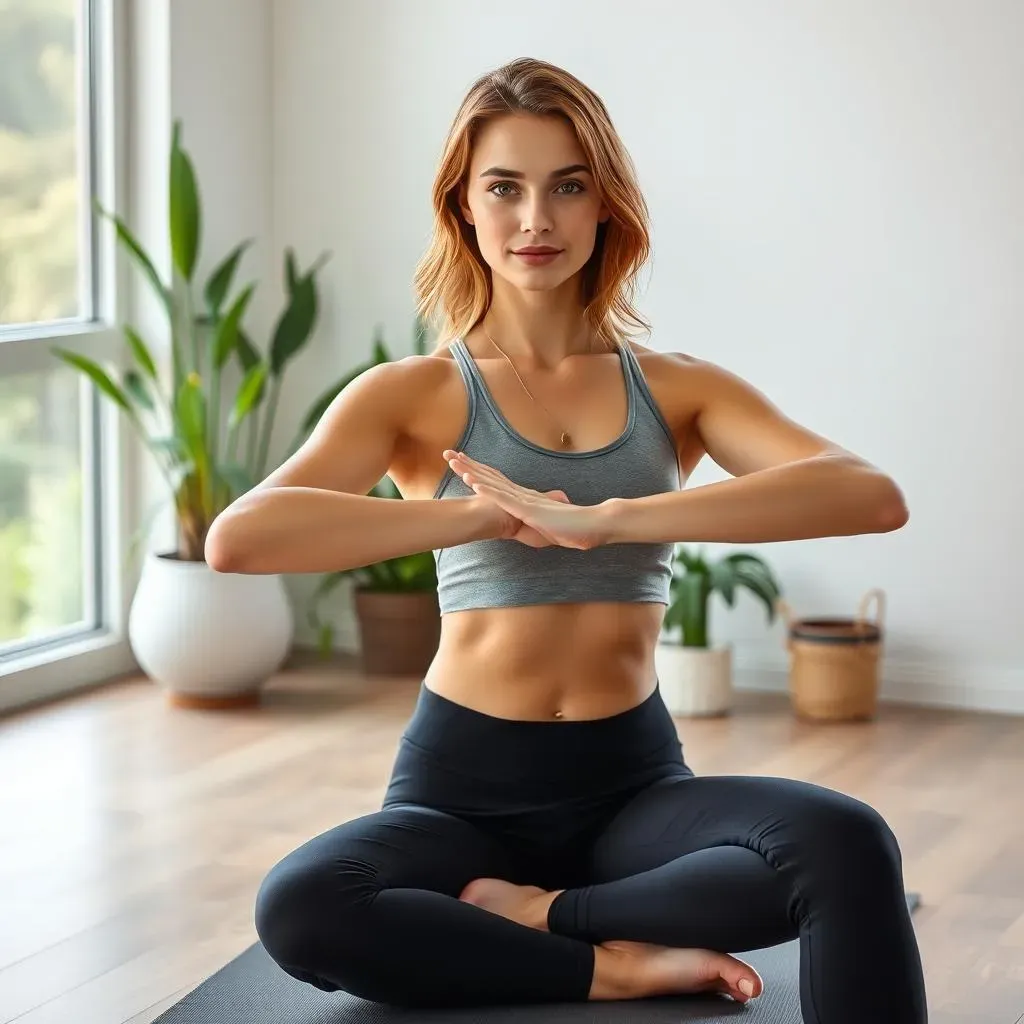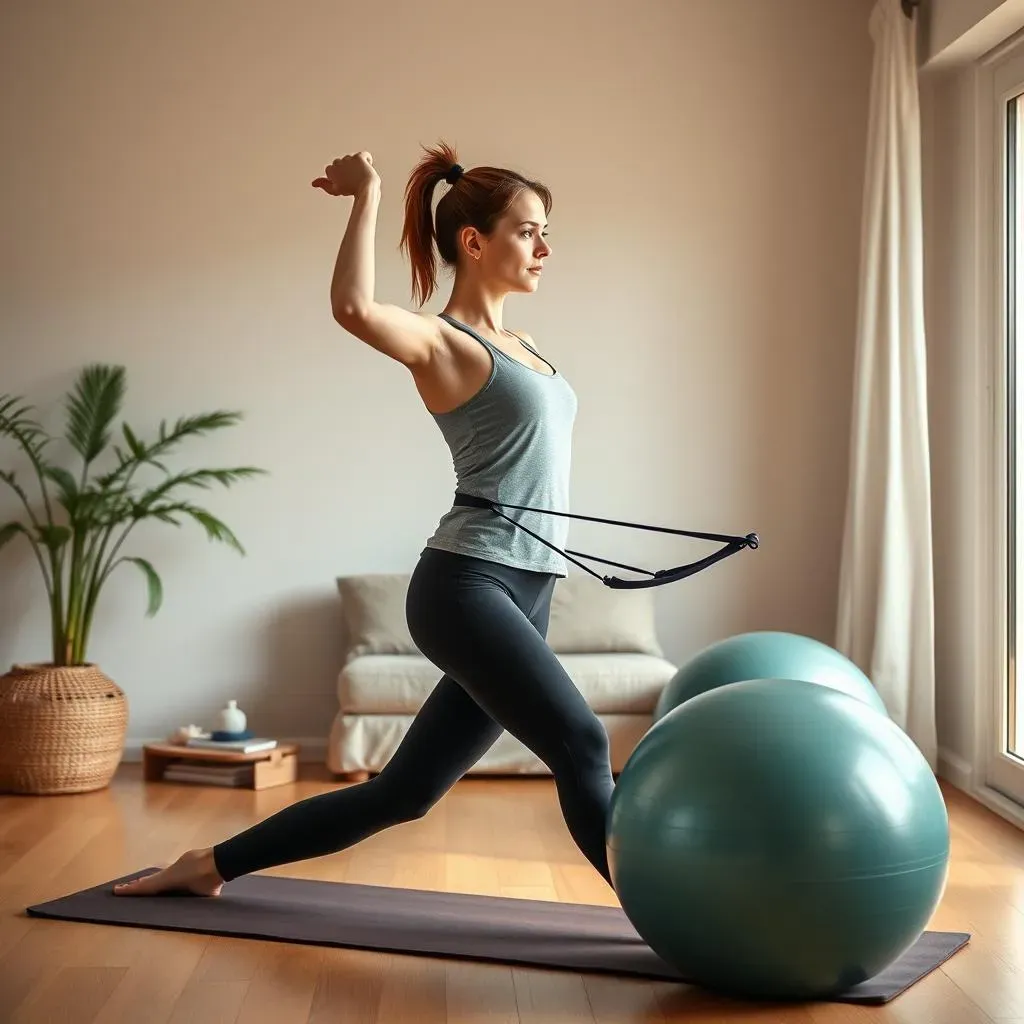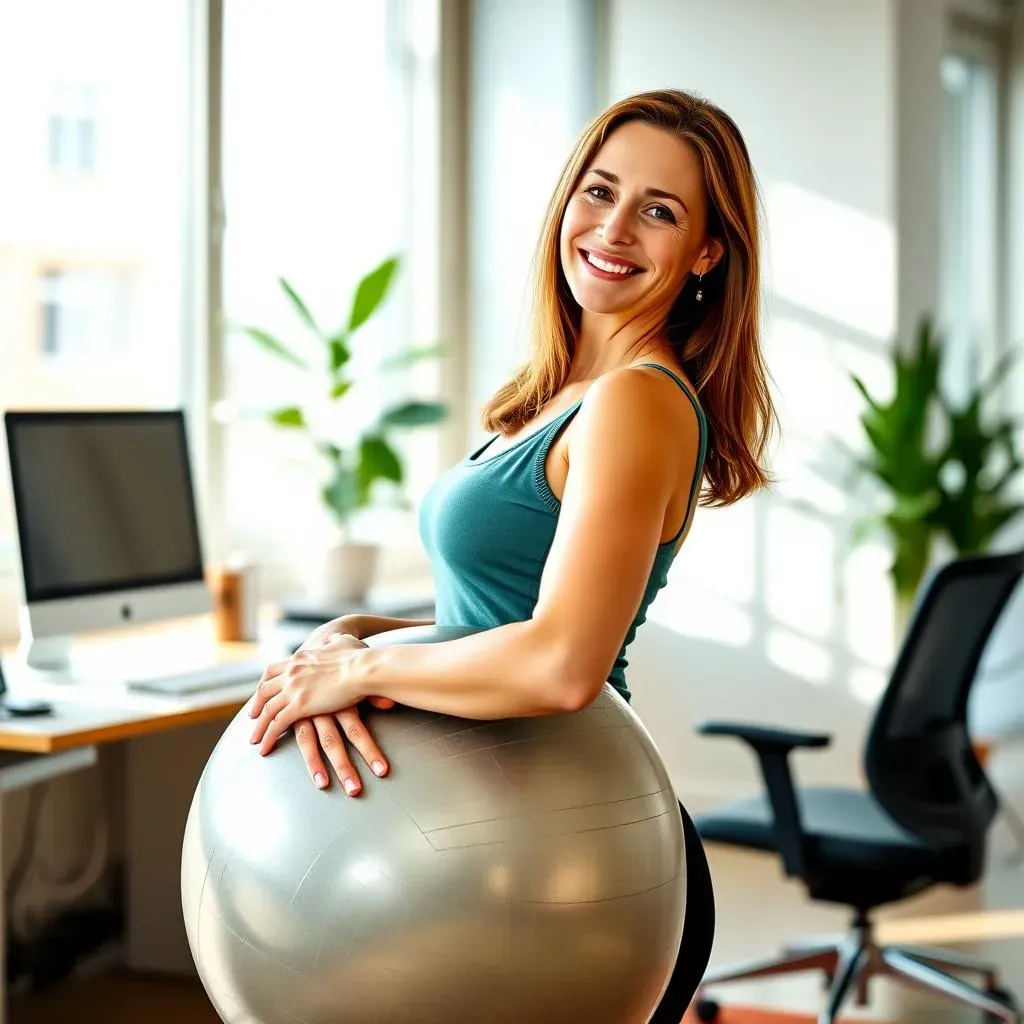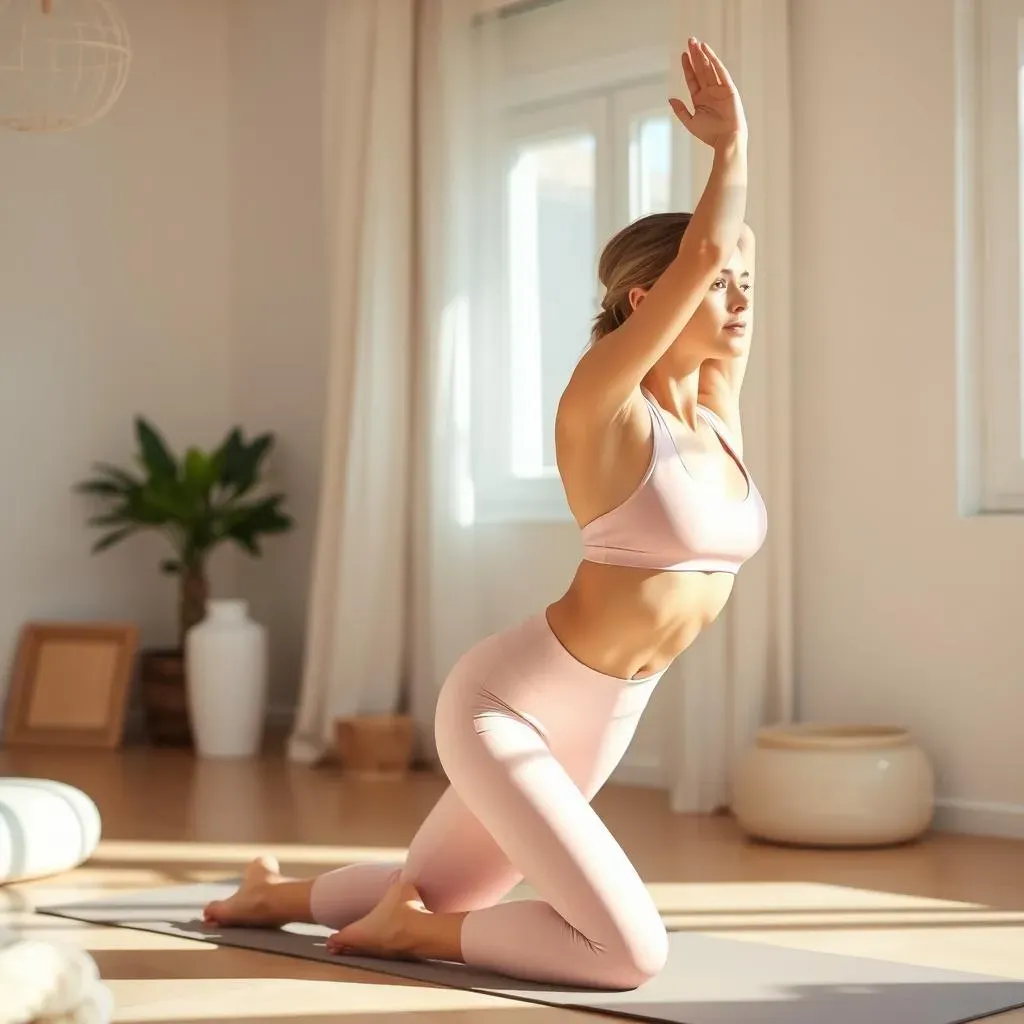Table of Contents
Are you tired of that nagging backache? Do you dream of standing tall and confident? Then get ready to discover the power of Pilates for posture, all from the comfort of your own home! This article is your ultimate guide to "pilates workout at home for posture," offering a simple yet effective path to improved posture and a healthier back. We'll explore the crucial link between posture and overall well-being, guiding you through essential Pilates exercises designed to strengthen your core, improve flexibility, and correct postural imbalances. We'll show you how to build a personalized at-home Pilates routine, complete with tips for maintaining good posture throughout your day. Whether you're a complete beginner or already familiar with Pilates, this article will equip you with the knowledge and practical exercises to achieve a straighter back and a more confident you. Let's embark on this journey to better posture together!
Understanding Posture and its Importance

Understanding Posture and its Importance
What is Good Posture, Anyway?
Think of your body as a stack of building blocks. Good posture means those blocks are neatly aligned, one on top of the other, creating a strong and balanced structure. When your posture is good, your bones, muscles, and joints work together efficiently. It's like a well-oiled machine! Poor posture, on the other hand, is like having those blocks all wobbly and misaligned. It puts extra strain on your muscles and joints, leading to aches, pains, and even long-term problems. Imagine carrying a heavy backpack – if it's not balanced correctly, you'll feel it in your back and shoulders. That's kind of how poor posture affects your body.
Maintaining good posture isn't just about looking good; it's about feeling good too! It improves your breathing, reducing strain on your lungs and diaphragm. When your posture is correct, your organs have more space to function optimally. Think of it as giving your insides a spacious and comfortable apartment instead of a cramped closet! Plus, good posture can even boost your confidence. Standing tall can make you feel taller and more powerful. If you're struggling with back pain, check out our guide to Pilates for back pain relief for more support.
Good Posture | Poor Posture |
|---|---|
Ears aligned over shoulders, shoulders relaxed, chest lifted, natural curve in lower back | Rounded shoulders, head forward, slumped back, excessive curve in lower back |
The Impact of Poor Posture
Poor posture isn't just about aesthetics; it significantly impacts your physical and mental well-being. It can lead to persistent headaches, neck pain, and back pain, often resulting in reduced mobility and a lower quality of life. Think about how much time you spend sitting—at your desk, in the car, or on the sofa. All that slouching puts a lot of stress on your spine and muscles. Over time, this can lead to muscle imbalances, stiffness, and even chronic pain. It's not just about the physical discomfort either; poor posture can also affect your mood and confidence. Slouching can make you feel tired and less energetic, impacting your overall mental health. If you're a beginner to Pilates, check out our beginner's guide to Pilates at home to start your journey.
The good news is that you can improve your posture with consistent effort. Pilates, with its emphasis on core strength and body alignment, is a fantastic tool for correcting postural issues. By strengthening your core muscles, you'll create a solid foundation for better posture. And by improving your flexibility, you'll be able to move more freely and comfortably. Remember, it's a journey, not a race. Start small, be patient, and celebrate your progress along the way. You’ll be amazed at the difference it makes in how you feel and move!
- Headaches
- Neck pain
- Back pain
- Reduced mobility
- Muscle imbalances
Essential Pilates Exercises for Posture Improvement

Essential Pilates Exercises for Posture Improvement
The Hundred
This classic Pilates exercise is all about breath control and core engagement. Lie on your back, knees bent, and lift your head and shoulders slightly. Extend your arms to the sides, then pump them up and down, inhaling for five counts and exhaling for five counts. Repeat this ten times—that's one "hundred"! It's deceptively challenging, but it's amazing for strengthening your core, which is the foundation of good posture. Think of it as building a strong base for your posture skyscraper! For a more challenging workout, try using resistance bands. Check out our guide on Pilates with resistance bands for more tips.
The Hundred improves core stability and endurance. It helps to lengthen and strengthen the abdominal muscles, which play a vital role in maintaining a neutral spine and upright posture. Consistent practice of this exercise will not only improve your posture but will also enhance your overall body awareness and coordination. Remember, even small improvements can make a huge difference over time.
- Improves core strength
- Enhances breath control
- Increases body awareness
Spine Stretch Forward
This exercise lengthens and strengthens your spine, counteracting the effects of hunching. Sit with your legs extended, and reach forward from your hips, keeping your spine long. The key here is to keep your back straight and avoid rounding. If you feel any discomfort in your lower back, stop immediately. This is a great exercise for improving flexibility in your back and hamstrings, which are often tight in people with poor posture. If you're looking for a more comprehensive Pilates workout, you might want to check out our best Pilates workout at home guide.
This exercise is great for stretching the muscles in your back, which helps to alleviate tension and improve flexibility. The lengthening action of the spine stretch forward improves your posture by counteracting the effects of habitual slouching or rounding of the shoulders. As your flexibility improves, you will naturally find it easier to maintain good posture throughout the day. Remember to focus on correct form rather than speed.
Step | Action |
|---|---|
1 | Sit tall with legs extended |
2 | Reach forward from the hips |
3 | Keep back straight, avoid rounding |
Swimming
This exercise strengthens your back muscles, which are crucial for maintaining good posture. Lie on your stomach, extend your arms and legs, and then lift them off the floor alternately. Imagine you're swimming! Focus on controlled movements and engage your core to prevent arching your back. This exercise is particularly helpful for those who tend to slouch or have a rounded upper back. For seniors who are looking for a gentle yet effective workout, we have a dedicated guide on Pilates for seniors at home.
Swimming strengthens the muscles of the back and shoulders, which helps to counteract the effects of poor posture. The controlled movements improve body awareness and coordination, which are important for maintaining good posture. It's a fantastic full-body exercise that improves strength, flexibility, and posture all at once. Remember to breathe deeply and focus on controlled movements.
"Pilates is not just about physical fitness; it's about building inner strength and a deeper connection with your body." - Joseph Pilates
Creating Your Home Pilates Routine for Posture

Creating Your Home Pilates Routine for Posture
Building Your Personalized Pilates Plan
Now that you've learned some fundamental Pilates exercises, it's time to craft your own personalized routine! Start by choosing 2-3 exercises from the ones we've covered—or explore others in our best Pilates workouts at home guide. Remember to listen to your body. If something feels uncomfortable, stop and modify the exercise or skip it altogether. Consistency is key, so aim for at least 15-20 minutes, 2-3 times a week. You can easily fit this into your daily schedule – maybe before breakfast, during your lunch break, or before bed. Remember, even short, regular sessions are more effective than infrequent, longer ones.
Beginners should focus on mastering the correct form before increasing the number of repetitions or sets. As your strength and flexibility improve, you can gradually increase the intensity and duration of your workouts. Think of it as building a strong foundation before adding more floors to your Pilates skyscraper! Don't forget to warm up before each session with some gentle stretches and cool down afterward with some deep breathing exercises. This will help prevent injuries and improve your overall flexibility. For those looking for a core-focused routine, check out our article dedicated to Pilates for core strength.
- Choose 2-3 exercises
- Start with 15-20 minutes, 2-3 times a week
- Focus on correct form
- Gradually increase intensity
- Warm up and cool down
Incorporating Pilates into Your Daily Life
The beauty of Pilates is that it's not just about the formal workout sessions; it's about integrating mindful movement into your daily life. Pay attention to your posture throughout the day. Are you slouching while sitting at your desk? Try sitting up straighter and engaging your core muscles. Are you hunching over your phone? Bring the phone up to eye level instead. These small adjustments can make a big difference over time. Think of it as constantly reinforcing the good posture habits you're building with your Pilates practice. If you find yourself struggling with back pain, you may find our guide on Pilates for back pain helpful.
Remember, improving your posture is a marathon, not a sprint. Be patient with yourself, celebrate your progress, and don't get discouraged by setbacks. Consistency is key, and even small improvements can lead to significant long-term benefits. Make it a habit to check your posture periodically throughout the day. Set reminders on your phone if needed. And most importantly, listen to your body. If something doesn't feel right, don't push yourself. Rest and recover, and then come back to your practice with renewed energy. For those new to Pilates, our beginner's guide can provide a solid foundation.
Time of Day | Posture Check | Adjustment |
|---|---|---|
Morning | Standing | Engage core, lengthen spine |
Afternoon | Sitting | Sit up straight, shoulders back |
Evening | Relaxing | Maintain neutral spine |
Maintaining Good Posture Beyond Your Pilates Practice

Maintaining Good Posture Beyond Your Pilates Practice
Ergonomics at Your Workspace
Your workspace is a major player in your posture game. Think about your desk setup. Is your monitor too low, forcing you to hunch? Raise it! Are your keyboard and mouse positioned awkwardly? Adjust them for optimal comfort. A good chair is your best friend; it should support your lower back and allow you to sit with your feet flat on the floor. Consider using a lumbar support pillow if your chair lacks proper back support. Remember, even small adjustments can make a big difference. Think of it like fine-tuning a musical instrument for the best sound—a well-tuned workspace leads to a well-tuned posture. If you're struggling with back pain, check out our article on Pilates for back pain relief for more support.
Take regular breaks from sitting. Get up and move around every 30-60 minutes. A quick walk, some stretches, or even just standing up and changing your position can help alleviate muscle stiffness and tension. Consider using a standing desk or incorporating periods of standing throughout your workday. These small changes can significantly impact your posture and overall well-being. Remember, our bodies weren't designed for prolonged periods of sitting.
Workspace Element | Ideal Setup |
|---|---|
Monitor | Top of screen at eye level |
Keyboard | Elbows at 90-degree angle |
Chair | Supports lower back, feet flat on floor |
Mindful Movement Throughout the Day
Pilates isn't just for your workout mat; it's a mindset! Become aware of your posture throughout the day. Are you slouching while watching TV? Sit up straighter. Are you hunching over your phone? Bring it up to eye level. These small adjustments, made consistently, can significantly impact your posture. Imagine your spine as a majestic tree; you want it to stand tall and proud, not bend under the weight of bad habits. For a more comprehensive Pilates workout, check out our best Pilates workout at home guide. It's packed with exercises to help you improve your posture.
Engage your core muscles regularly throughout your day. This doesn't require intense exercise; even subtle contractions can make a difference. Think of it as a gentle reminder to your body to maintain its alignment. This helps to support your spine and counteract the effects of slouching or poor posture. By strengthening your core, you're building a strong foundation for better posture. This mindful approach will help you maintain good posture, even outside your formal Pilates sessions. If you are looking for a more tailored routine, consider our Pilates for core strength guide.
- Be mindful of posture while sitting
- Engage core muscles regularly
- Take regular breaks to move
- Maintain good posture while standing
Seeking Professional Guidance
Sometimes, you need a little extra help. A physical therapist or Pilates instructor can assess your posture, identify any muscle imbalances, and create a personalized plan to address your specific needs. They can also provide valuable feedback on your form and technique, ensuring you're performing exercises correctly and safely. Think of them as your posture coaches, guiding you on your journey to better posture. They can offer personalized advice and adjustments, helping you achieve optimal results faster and more safely. If you're a beginner, you might find our beginner’s guide to Pilates helpful in getting started.
Don't hesitate to seek professional help if you're struggling with persistent back pain or other postural issues. A qualified professional can offer tailored exercises and advice, ensuring you're on the right track. Remember, investing in your posture is an investment in your overall health and well-being. It can lead to significant improvements in your daily life, boosting your energy levels, reducing pain, and enhancing your confidence. For seniors who are interested in incorporating Pilates into their routine, our Pilates for seniors at home guide offers gentle yet effective exercises.
